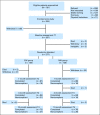Randomized controlled trial of expressive writing for patients with renal cell carcinoma
- PMID: 24470003
- PMCID: PMC3927735
- DOI: 10.1200/JCO.2013.50.3532
Randomized controlled trial of expressive writing for patients with renal cell carcinoma
Abstract
Purpose: This randomized controlled trial examined the quality-of-life benefits of an expressive writing (EW) intervention for patients with renal cell carcinoma (RCC) and identified a potential underlying mechanism of intervention efficacy.
Patients and methods: Patients (N = 277) with stage I to IV RCC were randomly assigned to write about their deepest thoughts and feelings regarding their cancer (EW) or about neutral topics (neutral writing [NW]) on four separate occasions. Patients completed the Center for Epidemiologic Studies Depression Scale (CES-D), MD Anderson Symptom Inventory (MDASI), Brief Fatigue Inventory (BFI), Pittsburgh Sleep Quality Index (PSQI), Medical Outcomes Study Short Form-36 (SF-36), and Impact of Event Scale (IES) at baseline and 1, 4, and 10 months after the intervention.
Results: The mean age of participants (28% stage IV; 41% female) was 58 years. Multilevel modeling analyses, using a Bonferroni-corrected α = .021 for six outcomes adjusted for the correlation among outcomes, revealed that, relative to the NW group, patients in the EW group reported significantly lower MDASI scores (P = .003) and higher physical component summary scores on the SF-36 (P = .019) at 10 months after the intervention. Mediation analyses revealed that significant group differences for MDASI scores at 10 months were mediated by lower IES scores at 1 month after the intervention in the EW group (P = .042). No significant group differences were observed in the BFI, CES-D, PSQI, and mental component summary of the SF-36.
Conclusion: EW may reduce cancer-related symptoms and improve physical functioning in patients with RCC. Evidence suggests that this effect may occur through short-term improvements in cognitive processing.
Trial registration: ClinicalTrials.gov NCT00505310.
Conflict of interest statement
Authors' disclosures of potential conflicts of interest and author contributions are found at the end of this article.
Figures




Similar articles
-
Examination of moderators of expressive writing in patients with renal cell carcinoma: the role of depression and social support.Psychooncology. 2017 Sep;26(9):1361-1368. doi: 10.1002/pon.4148. Epub 2016 May 3. Psychooncology. 2017. PMID: 27145447 Free PMC article. Clinical Trial.
-
A pilot study of the effects of expressive writing on psychological and behavioral adjustment in patients enrolled in a Phase II trial of vaccine therapy for metastatic renal cell carcinoma.Health Psychol. 2002 Nov;21(6):615-9. doi: 10.1037//0278-6133.21.6.615. Health Psychol. 2002. PMID: 12433015 Clinical Trial.
-
Harnessing benefits of helping others: a randomized controlled trial testing expressive helping to address survivorship problems after hematopoietic stem cell transplant.Health Psychol. 2014 Dec;33(12):1541-51. doi: 10.1037/hea0000024. Epub 2013 Nov 25. Health Psychol. 2014. PMID: 24274798 Clinical Trial.
-
Effects of expressive writing intervention for women's PTSD, depression, anxiety and stress related to pregnancy: A meta-analysis of randomized controlled trials.Psychiatry Res. 2020 Jun;288:112933. doi: 10.1016/j.psychres.2020.112933. Epub 2020 Apr 14. Psychiatry Res. 2020. PMID: 32315889 Review.
-
The Effects of Expressive Writing Interventions for Patients With Cancer: A Meta-Analysis.Oncol Nurs Forum. 2016 Jul 1;43(4):468-79. doi: 10.1188/16.ONF.468-479. Oncol Nurs Forum. 2016. PMID: 27314189 Review.
Cited by
-
Effects of Angelica Fritillaria Kushen Pill on Renal Function and Immune Function after Laparoscopic Radical Nephrectomy for Patients with Renal Carcinoma.J Healthc Eng. 2022 Mar 25;2022:4082121. doi: 10.1155/2022/4082121. eCollection 2022. J Healthc Eng. 2022. Retraction in: J Healthc Eng. 2023 Aug 9;2023:9856873. doi: 10.1155/2023/9856873. PMID: 35368912 Free PMC article. Retracted.
-
A Bayesian semiparametric latent variable approach to causal mediation.Stat Med. 2018 Mar 30;37(7):1149-1161. doi: 10.1002/sim.7572. Epub 2017 Dec 18. Stat Med. 2018. PMID: 29250817 Free PMC article.
-
Distress Management, Version 3.2019, NCCN Clinical Practice Guidelines in Oncology.J Natl Compr Canc Netw. 2019 Oct 1;17(10):1229-1249. doi: 10.6004/jnccn.2019.0048. J Natl Compr Canc Netw. 2019. PMID: 31590149 Free PMC article.
-
Interconnection: A qualitative analysis of adjusting to living with renal cell carcinoma.Palliat Support Care. 2018 Apr;16(2):146-154. doi: 10.1017/S1478951517000074. Epub 2017 Mar 6. Palliat Support Care. 2018. PMID: 28262086 Free PMC article. Clinical Trial.
-
Improving Maternal Mental Health Following Preterm Birth Using an Expressive Writing Intervention: A Randomized Controlled Trial.Child Psychiatry Hum Dev. 2016 Oct;47(5):780-91. doi: 10.1007/s10578-015-0611-6. Child Psychiatry Hum Dev. 2016. PMID: 26659113 Clinical Trial.
References
-
- Redd WH, DuHamel KN, Johnson Vickberg SM, et al. Long-term adjustment in cancer survivors: Integration of classical-conditioning and cognitive processing models. In: Baum A, Andersen BL, editors. Psychosocial Interventions for Cancer. Washington, DC: American Psychological Association; 2001. pp. 77–97.
-
- Green BL, Epstein SA, Krupnick JL, et al. Trauma and medical illness: Assessing trauma-related disorders in medical settings. In: Wilson JP, Keane TM, editors. Assessing Psychological Trauma and PTSD. New York, NY: The Guilford Press; 1997. pp. 160–191.
-
- Cordova MJ, Andrykowski MA, Kenady DE, et al. Frequency and correlates of posttraumatic stress disorder–like symptoms after treatment for breast cancer. J Consult Clin Psychol. 1995;63:981–986. - PubMed
-
- Greenberg MA. Cognitive processing of traumas: The role of intrusive thoughts and reappraisals. J Appl Soc Psychol. 1995;25:1262–1296.
Publication types
MeSH terms
Associated data
Grants and funding
LinkOut - more resources
Full Text Sources
Other Literature Sources
Medical

